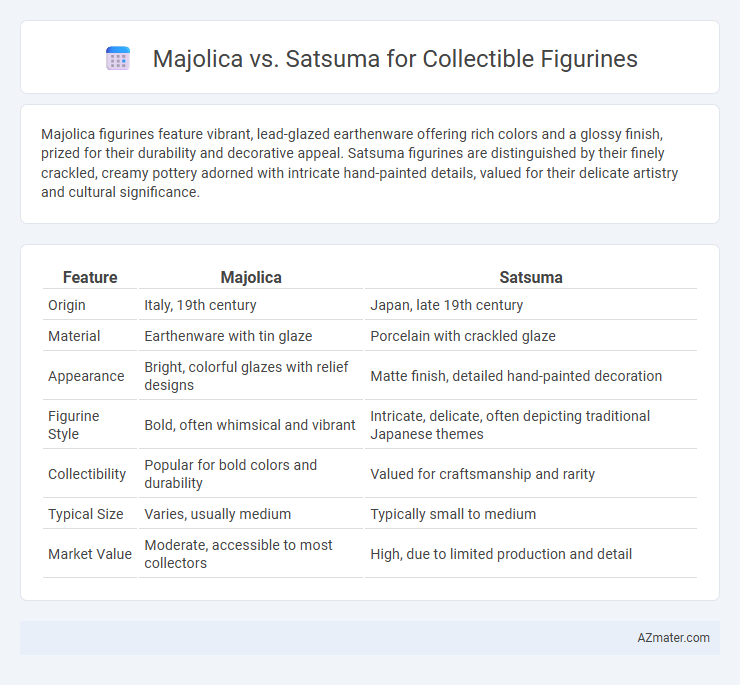Majolica figurines feature vibrant, lead-glazed earthenware offering rich colors and a glossy finish, prized for their durability and decorative appeal. Satsuma figurines are distinguished by their finely crackled, creamy pottery adorned with intricate hand-painted details, valued for their delicate artistry and cultural significance.
Table of Comparison
| Feature | Majolica | Satsuma |
|---|---|---|
| Origin | Italy, 19th century | Japan, late 19th century |
| Material | Earthenware with tin glaze | Porcelain with crackled glaze |
| Appearance | Bright, colorful glazes with relief designs | Matte finish, detailed hand-painted decoration |
| Figurine Style | Bold, often whimsical and vibrant | Intricate, delicate, often depicting traditional Japanese themes |
| Collectibility | Popular for bold colors and durability | Valued for craftsmanship and rarity |
| Typical Size | Varies, usually medium | Typically small to medium |
| Market Value | Moderate, accessible to most collectors | High, due to limited production and detail |
Introduction to Majolica and Satsuma Figurines
Majolica and Satsuma figurines represent two distinct collectible ceramics, each with unique origins and craftsmanship. Majolica figurines, typically vibrant and colorful, are made using a lead-glazed earthenware technique developed in 19th-century Europe, especially England and Italy, characterized by intricate, decorative designs and glossy finishes. Satsuma figurines hail from Japan, recognized for their finely detailed hand-painted designs on a creamy, crackled glaze, often depicting traditional Japanese themes and motifs, making both types highly sought after by collectors worldwide.
Historical Origins of Majolica and Satsuma
Majolica ceramics originated in 15th-century Italy, characterized by vibrant tin-glazed earthenware with intricate, colorful designs often depicting Renaissance themes. Satsuma pottery dates back to 17th-century Japan, initially produced in the Satsuma Province, renowned for its creamy, crackled glaze and elaborate hand-painted decorations featuring traditional Japanese motifs. Collectible figurines from both Majolica and Satsuma reflect their distinct cultural heritages, with Majolica emphasizing European Renaissance art and Satsuma highlighting Japanese craftsmanship and aesthetics.
Key Characteristics of Majolica Figurines
Majolica figurines are characterized by their vibrant, glossy glazes and intricate hand-painted designs, often featuring naturalistic themes such as animals, flowers, and whimsical characters. These ceramic pieces are typically made from earthenware clay and exhibit a distinctive, brightly colored surface achieved through tin or lead glazing techniques. Collectors value Majolica figurines for their unique glazing effects, detailed craftsmanship, and the rich historical context of their 19th-century European origin.
Defining Features of Satsuma Collectibles
Satsuma collectibles are defined by their intricate hand-painted designs, featuring detailed, raised enamel decorations often depicting traditional Japanese scenes and motifs such as geishas, flowers, and mythical creatures. The cream-colored, crackled glaze characteristic of Satsuma pottery enhances the antique aesthetic and distinguishes it from the smoother, glossy finish of Majolica. Unique to Satsuma is the use of gold accents and the presence of finely incised signatures or marks from the specific kiln or artist, adding provenance and value to each piece.
Artistic Techniques: Majolica vs. Satsuma
Majolica figurines feature vibrant, lead-glazed earthenware with brightly colored, often floral patterns achieved through tin-glazing techniques originating in 19th-century Europe. In contrast, Satsuma figurines showcase intricate hand-painted designs on creamy, crackle-glazed porcelain, emphasizing detailed scenes and gold embellishments rooted in Japanese Edo-period craftsmanship. The artistic techniques of Majolica prioritize bold, glossy surfaces with relief textures, while Satsuma relies on delicate brushwork and matte finishes to convey refined elegance.
Popular Themes and Motifs in Each Style
Majolica collectible figurines often feature vibrant, nature-inspired themes such as animals, flowers, and mythological creatures, characterized by their bold, colorful glazes and textured surfaces. In contrast, Satsuma figurines emphasize detailed human figures, including geishas, samurai, and historical scenes, with intricate hand-painted designs and gold accents reflecting traditional Japanese culture. Collectors value Majolica for its whimsical natural motifs and Satsuma for its refined, culturally rich depiction of people and stories.
Rarity and Value in Collecting Majolica and Satsuma
Majolica figurines are prized for their vibrant, glossy glazes and whimsical designs, making them relatively common yet highly desirable among collectors due to mass production in the 19th and early 20th centuries. Satsuma figurines, originating from Japan and characterized by intricate hand-painted details and crackled glaze, are rarer and often valued higher because of their limited production and cultural significance. Collectors prioritize Satsuma for its unique artistry and scarcity, while Majolica offers accessible, colorful charm with moderate investment potential.
Authenticity Tips: How to Identify Genuine Pieces
Majolica collectible figurines feature vibrant, colorful glazes and intricate, hand-painted designs, often stamped or marked on the base with the manufacturer's name or origin, making these details essential for authenticity verification. Satsuma figurines are characterized by their distinctive creamy, crackled earthenware surface adorned with detailed, hand-painted Japanese motifs and signatures from known artists or studios, which help to distinguish genuine pieces from reproductions. Examining the texture, glaze quality, precise markings, and provenance documentation are key steps collectors use to confidently identify authentic Majolica and Satsuma figurines.
Market Trends and Investment Potential
Majolica collectible figurines exhibit vibrant glazes and intricate designs that appeal to collectors seeking decorative and artistic value, with market trends showing steady appreciation due to their uniqueness and craftsmanship. Satsuma figurines, renowned for their detailed hand-painted motifs and cultural significance, continue to attract investors interested in Asian antiques, demonstrating strong demand and increasing auction prices globally. Both Majolica and Satsuma hold considerable investment potential, with Majolica favored for its bold aesthetics and Satsuma prized for its historical and cultural provenance.
Choosing Between Majolica and Satsuma for Your Collection
Majolica figurines are known for their vibrant glaze, intricate floral patterns, and durability, making them ideal for collectors who prefer bold, colorful pieces with a lively finish. Satsuma figurines feature fine crackled pottery with delicate hand-painted designs, often depicting traditional Japanese scenes or mythological figures, perfect for enthusiasts valuing detailed craftsmanship and historical authenticity. When choosing between Majolica and Satsuma, consider the aesthetic appeal, cultural origin, and condition, as well as market demand and rarity for each type in your collectible figurine collection.

Infographic: Majolica vs Satsuma for Collectible Figurine
 azmater.com
azmater.com